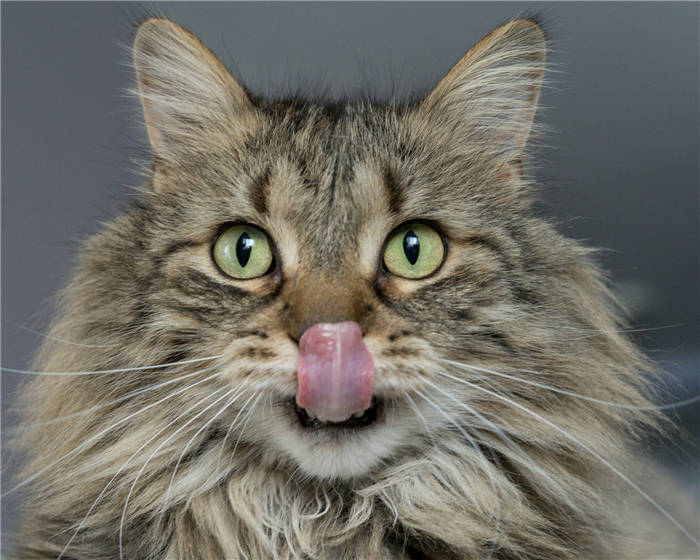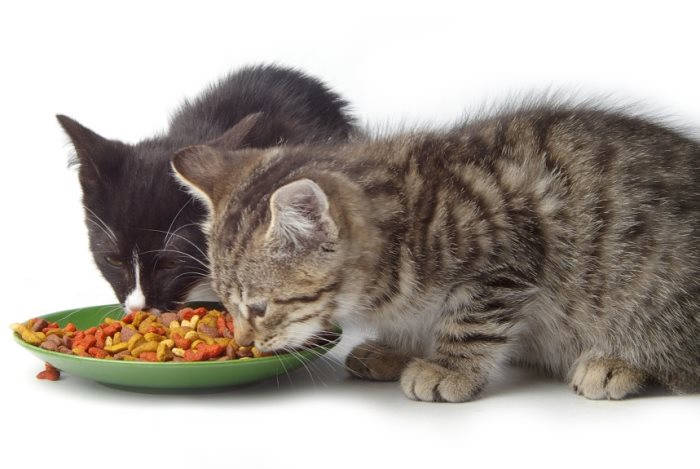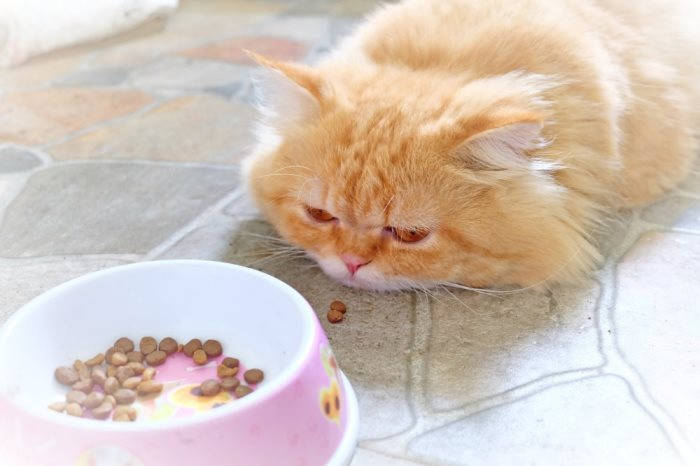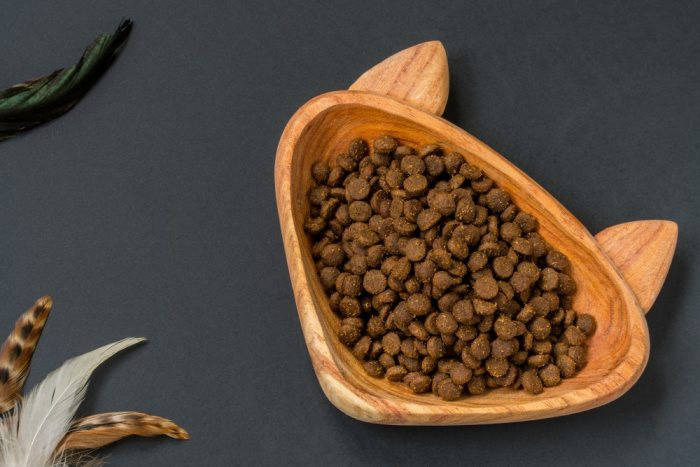When the cat is completely switched to soaked food, start accustoming him to dry food. Add a few bites and mix it up. Add more next time.

- How to train your cat to dry food
- Introduce dry food to your cat
- How to train a cat to dry food: hunger in the balance
- Water and dry food are inseparable
- Keep water readily available
- A word to the owner
- Monitor your cat's reaction
- The gradual transition method
- Make the food more appealing
- How do you train a cat to eat what you give him?
- Get your cat used to dry food by "starvation".
- At what age to transfer?
- Choice of food
- Premium Class
- Super Premium
- How to train your kitten to dry food
- Tricks and nuances of accustoming to the dry food
- How to accustom a cat to ready-made dry food
- What you need to know when transferring an adult cat after a regular meal
How to train your cat to dry food
Switching from a natural diet to dry food but worried about how he'll take it? Our detailed instructions will help you do it without worrying about both the cat and its owner. We'll also remind you of the basic rules of dry food.
Get the cat used to eating around the same time, rather than begging for something tasty every time you walk into the kitchen. Ideally, the ponytail will eat everything offered to him, leaving the bowl empty or almost empty, but he won't starve until the next time.
Two feedings a day is enough for an adult, because food is digested in the gastrointestinal tract within 8-12 hours. Kittens and pets with certain health problems should be fed more often, consult your veterinarian if this is your case.
It's more convenient to adjust your pet's feeding regimen to your daily routine. If that fails, focus on cats' natural biorhythms. In nature they are more likely to hunt (and eat their prey) in the early morning and at dusk.
Introduce dry food to your cat
Cats are often wary of unfamiliar foods. The aim of this step is simply to introduce the cat to the dry food so that it will not be rejected with a new smell or an unfamiliar consistency.
Try offering a few pellets from the palm of your hand as you interact with your pet. Petting, scratching behind the ear and offering praise so he associates the new food with pleasure. If the cat doesn't want to eat it, that's okay, try again later.
You can put the pieces in a puzzle or a feeder toy as a treat. Many cats are more interested in eating what they "got" themselves.
Our pet carnivores are attracted to the smells of meat, poultry and fish, so they are more willing to try foods with a predominance of animal proteins. Such diets are also healthier for cats because they take into account their nutrient requirements.

How to train a cat to dry food: hunger in the balance
If all the tricks don't work and the cat refuses to eat dry food without any additives, then try a change of diet. Cats have their own food preferences and they will probably eat different foods more readily.
Advice for drastic measures: Eliminate all other food and don't give the cat treats or treats from the table, so that it has no choice but to eat what it is given. Cats can starve without any harm for up to three days, but hunger, of course, causes discomfort to the animal, so that sooner or later its stubbornness will be broken.
Water and dry food are inseparable
As a rule, dry food does not need to be supplemented with anything other than fresh water. And this is the most important aspect when feeding dry food to a cat. A cat on dry food needs to drink more than usual, so fresh water should always be readily available. It is better to place several bowls around the house, if possible near the cat's favorite places.
It will be several months before you can assess whether the food is suitable for the cat. Important factors are the condition of his skin and coat, the quality of his stools and his urine output – if the cat urinates less than twice a day you should increase his water intake, or supplement his dry food with a canned food such as a dry food.
Keep water readily available
After changing his food it is important to monitor the cat's drinking behavior. There is hardly any moisture in the dry food, which means that the cat has to get it separately. Clean drinking water should be readily available 24 hours a day. If it is cloudy, replace it with fresh water.
Sometimes a cat doesn't even touch the water bowl, but likes to drink from the tap. It is better to give him this opportunity, because the chronic lack of liquid against the background of dry food can lead to diseases of the urinary system. But we shouldn't allow pets to drink from the toilet bowl: it may contain detergent residues and pathogens, provoking poisoning.
A word to the owner
- While you are accustomed to the food, refuse wet canned foods, treats and treats. A full-food product already has everything you need for your cat's body. You should not add anything to it except water, otherwise the cat is likely to be cranky.
- Daily allowance is on the package, and you should check the cat's weight every 2-3 months. It is easy to overfeed a pet with dry food, and owners of neutered or sedentary cats should be especially careful.
- If a cat does not eat the whole portion offered, do not worry and do not rush to change its ration. Cats eat small portions. It is absolutely normal for them to put food in their bowl 10-15 times during the day, and even at night. Fill the bowl twice a day and let the cat eat whenever he wants.
- Acana and Orijen products contain a lot of meat components, so most animals will eat them willingly without additional tricks and entreaties.
Dry food is suitable for pets of all ages and breeds. In most cases, this diet will be more balanced than natural food, and even more so food from the human table. But before you add a cat with a chronic illness to dry food, you should talk to your vet.
Monitor your cat's reaction
When you accustom your kitten to dry food, watch closely to see what happens. If the baby is happy and active, puts on weight well and its gastrointestinal tract works like clockwork, then the food is correct. If the pet has liquid stools or constipation, allergy symptoms (itching, rash, hair loss), you need to suspend the transition to the new food and seek advice from your veterinarian.
The gradual transition method
If your cat has never tried dry food, you shouldn't start with drastic measures. Instead you need to take it one step at a time, gently introducing the unfamiliar food and basing your cat's reaction on it. For example, when feeding, put a small bowl full of dry kibble next to his bowl. Perhaps the pet will show interest in the new food and prefer it over the familiar food.
If not, try pouring pellets in water and mashing them with a fork. In this way, the aromatic properties of the food become more pronounced and its consistency becomes closer to natural food. Then you can add dry pellets to the bowl little by little, increasing the amount each day while reducing the amount of soaked food.
Make the food more appealing
It is advisable to offer the cat a new portion each time, as moistened pellets quickly become stale and spoiled. Once you get your pet used to eating dry food, the bowl can be filled twice a day. The main thing is to stick to the daily quota indicated by the manufacturer on the package. This will help to avoid overfeeding, which often leads to excessive picky eating.
Blitz cat foods contain natural flavor additives that make it easier for cats to become accustomed to dry food. Most animals eat our products voluntarily, without any additional tricks.
If the cat does not want to even look at the bowl, try mixing pellets with wet canned food in a 1:4 ratio. Then increase the share of dry food daily, gradually bringing it to 100%. Normally, the transition to a new type of food should take 7-10 days.
How do you train a cat to eat what you give him?
The taste and smell of the food is very important to cats. Therefore, when you transfer your pet to a new type of food or a different brand of food, it is better to act gradually, rearranging the diet over the course of a week. At first, replace no more than 20% of the portion with the new food. Then every day increase its share, bringing it to 100%.
The cat feels the familiar flavor and eagerly starts eating. In addition, the gradualness of the change of diet insures the cat against digestive problems during the adaptation period.
Unfortunately this "canonical" method does not work with fastidious cats. Even with an almost homogeneous mass of food, they are able to discard small particles that they don't like. As a result, the pellets of new food remain in the bowl, and the animal goes hungry and unhappy. Well, we'll have to resort to more drastic measures.
Get your cat used to dry food by "starvation".
The idea of making a cat starve seems cruel to loving owners. Actually it's no big deal: it's not always the case that cats in the wild eat their fill. But we have to remember that they hunt small game, which they catch much more often than big game, so, unlike dogs, they are not adapted to long hunger strikes.
Without harm to health, cats can do without food no more than three days. At the same time periodic starvation will not only improve the appetite of fastidious cats, but will be an excellent prevention of obesity, which is extremely important for sedentary and neutered animals.
- Remove the bowl of food and do not give the pet any other food for 24 hours;
- Don't pay attention to the mournful looks and pitiful meows;
- Stand your ground, even if he won't let you pass;
- The next day you return the bowl with the food you want to teach the cat.
Sooner or later he will start to eat. If it did not help at the first time, you can repeat the procedure. And do not worry about your conscience: all this is not done in order to punish the capricious cat, but for his own benefit. After all, the purpose of changing the food is to improve the quality of nutrition, and therefore improve health.
Often cats reject the dry medical food recommended by the veterinarian, and in this case no concessions are out of the question.
At what age to transfer?
Ready-made products are a convenient solution for pet owners, as the product will not be able to spoil and will not require any cooking. But not all dry food can be suitable for the diet of small pets, this food must be given at a certain age of the kitten.
Kittens' stomachs and intestines are too soft and sensitive, so dry food will cause minor mucous membrane injuries. Babies need to diversify their food, rather than giving them a purely dry product right away. In addition to food, you can offer milk, kefir, cottage cheese, boiled chicken, boiled eggs.
Dry products should be of high quality, it is better to choose food that is intended only for small kittens.
Dry food can be given to kittens who are 1.5 months old, but such food must be prepared in advance. Milk containing little lactose should be poured on top of the dry pellets. Non-fat kefir, broth or water can also be used. Dry food is often mixed with meat ingredients. Then you need to wait until the liquid has been absorbed into the food and the pellets have swollen. As soon as the pellets have increased in size, you should take a fork and crush the food so that it becomes mush.
So that the kitten can quickly switch to dry food, its mother should be fed the same food during lactation. Do not give your kitten only dry pellets, alternate them with finely chopped pieces of meat, poultry or fish fillets.
When the kitten is 2 months old you will need to dilute the dry food with less and less milk, and do not mix dry food with soft food. Transition to dry food should be gradual. At 2.5 months, the baby will have developed all the palatability, and will need the minimum of liquid. At 3 months of age, pellets can be given without any liquid.
Since kittens have small stomachs, they cannot feel the fullness from the food. For this reason, kittens themselves do not understand how much food they want to eat. Owners should take this into account and put small portions of dry food 4 times a day. Always leave clean water for kittens who eat dry food.
Choice of food
Before you buy dry food for your pets, you need to know the name and composition of all dry food.
Economy class foods may contain bone meal (instead of meat), vegetable matter and poor quality. Colorants and flavorings are added to make the food attractive. Premium products have selected ingredients and have all the vitamins and minerals they need. Sources of protein will be meat components, poultry and fish. The vegetable element is corn. High digestibility and cost-effectiveness can be considered as characteristic features of good food.
Super Premium dry mixes are made from products of the highest quality: salmon fillets, eggs and rice. These foods contain proteins, fats and carbohydrates, these substances can be obtained from the main ingredients. This kind of food has a higher energy value than cheap or even just a premium food. With this kind of food, your kitten will get the most important nutrients every day.
Premium Class
Selecting a menu for kittens is not an easy and responsible task. Babies who are just starting their development need nutritious, balanced and wholesome food. balanced substances.
- Royal Canin. It can be given to kittens from six months. Such products contain a complex with easily digestible proteins and fiber, which improve digestion and normalize stools. This product also contains antioxidants and vitamin-mineral elements.
- Hill`s Science Plan Kitten. It contains omega-3 acids, protein, taurine, phosphorus, calcium and other elements that can ensure normal growth of a kitten. Kitten can be given tuna or chicken, they have animal protein. This food will strengthen your pet's immune system, teeth and bones will be healthy.
Super Premium
To ensure that your pet's food contains only the finest and highest quality foods, you should choose dry food from the Super Premium category.
How to train your kitten to dry food
The main rule in this case – gradualness and slowness. Of course, there are cases where kittens immediately and "without talking" begin to eat dry food. Here's just do not do that, because such a sharp transition – almost 100% guarantee of digestive problems. And in the case of kittens, they can lead to fatal consequences. And so inoculation to the dry food held in several stages:
- First they conduct an "investigative experiment". On the example of small amounts of dry food from different manufacturers (once again we remind you that food should be "baby food") you need to understand what kind of food kitten likes, and pellets what product he eagerly eats the most.
- After that, 5% "dryness" is added to the pet's diet every day. No more is needed, the baby's digestive system must get used to the new food.
- If any bad signs appear (diarrhea, bloating, poorly formed feces) the percentage of dry food for two or three days is left at the same level. If at the end of this period the symptoms persist, the food should be changed. And from the moment of replacement, it is better to start everything from the beginning (i.e. with 5% of the new food per day).
- The complete transition to a new food takes at least three weeks, and ideally it should be stretched to a month.
Also. At least up to a year old kitten needs and wet food. So "dry" is better to alternate with high-quality canned food, and ideally – from the same manufacturer and the same brand. Mix feeds we strongly advise not to!
Tricks and nuances of accustoming to the dry food
That the pet ate better dry food, you can use small tricks:

- In the first month of domestication we recommend slightly soaking the pellets in low-fat meat broth. In this case the benefit is twofold: the kitten eats better and his thin teeth are subjected to much less stress, which has a positive effect on the formation and health of the entire jaw system.
- There should always be a bowl of clean drinking water near the food bowl. The animal should be able to drink plenty of water at any time! This, by the way, is important not only for kittens, but also for adult pets.
- Choose food from the "Premium" or "Super-Premium" category. In such diets, there is a maximum of meat. This, firstly, improves the taste of the food (kittens eat better). Secondly, this diet is much healthier for the growing body of the baby than if you compare it with the food "Economy" class.
How to accustom a cat to ready-made dry food
If you made a choice in favor of dry food, or there was an urgent need to transfer an adult cat to a new type of food, you will have to be patient. The transition from liquid food, natural products to dry food must be gradual, consistent, and it will take an average of 9-12 days.
Important! A sudden change of diet is a serious stress to the body of the pet. Cats have a very sensitive gastrointestinal tract. Therefore, if you change the diet abruptly, it may provoke a metabolic disorder, failure of the digestive tract organs.
Some cats immediately eagerly eat dry food after meat, fish and porridge, and owners have no problems with the transition to the new diet, others, more finicky individuals, reluctant to eat the proposed treat or move away from the bowl, demonstrating all his species of dissatisfaction.
If your cat refuses food and does not understand why there is no familiar food in the bowl. You should not scold or try to force-feed the animal. Even if the pet goes hungry for two days, there will be no harm to its health.
A short-lived diet even in some way will benefit the body of the pet. So if the cat refuses to eat, meows, begging for his favorite treat, do not go along with the pet. Otherwise the transition to a ready-made diet will drag on for many months.

It's best to start with wet food to switch to a ready-to-eat diet. "Packets" have a pleasant aroma, rich flavor, and consistency that is similar to natural food. They can be added to the usual food. As a rule, after a wet food, cats are eager to eat dry food pellets.
Tip: Use wet and dry food of the same brand or brand to feed your pet.
The first time pellets can be soaked in milk, fish or meat broth or ground into powder and mixed with natural food. In doing so, mix the food well so that the cat does not have the opportunity to pick out pieces of meat or fish.
What you need to know when transferring an adult cat after a regular meal
If you decide to feed your cat ready-made dry food after a regular meal, a natural diet, give preference to products of well-known brands and brands of the category "premium", "super-premium", "extra-class".
They have a fully balanced composition, enriched with essential amino acids, minerals, vitamins. The composition includes natural healthy ingredients for the health of cats.
The best dry pet food is produced by the following brands:
Prepackaged "economy-class" foods contain low-quality ingredients, processed products (skins, fats, by-products). Their composition includes flavorings, flavor enhancers, stabilizers, other substances and components harmful to the body of animals. Prolonged use may cause food allergies, IBC, digestive and metabolic disorders.
When choosing dry food for your beloved pet, consider the age, breed, individual, physiological characteristics of the body, level of activity. There are foods for neutered/sterilized animals, pregnant, lactating females. Strictly adhere to the daily dosage indicated on the package.
Important: You should feed not more than 30-35 g of dry food per 1 kg of body weight, based on energy requirements: 230-250 kcal for cats, 300-320 kcal for males. Do not overfeed. Give food at the same time.

Never feed an adult cat food that is intended for dogs, kittens. This can lead to digestive disorders, other internal organ disorders.
Make sure that the cat always has clean, fresh drinking water in its bowl. Because dry food contains minimal moisture, and if the cat does not consume water, dehydration (dehydration) can develop.






